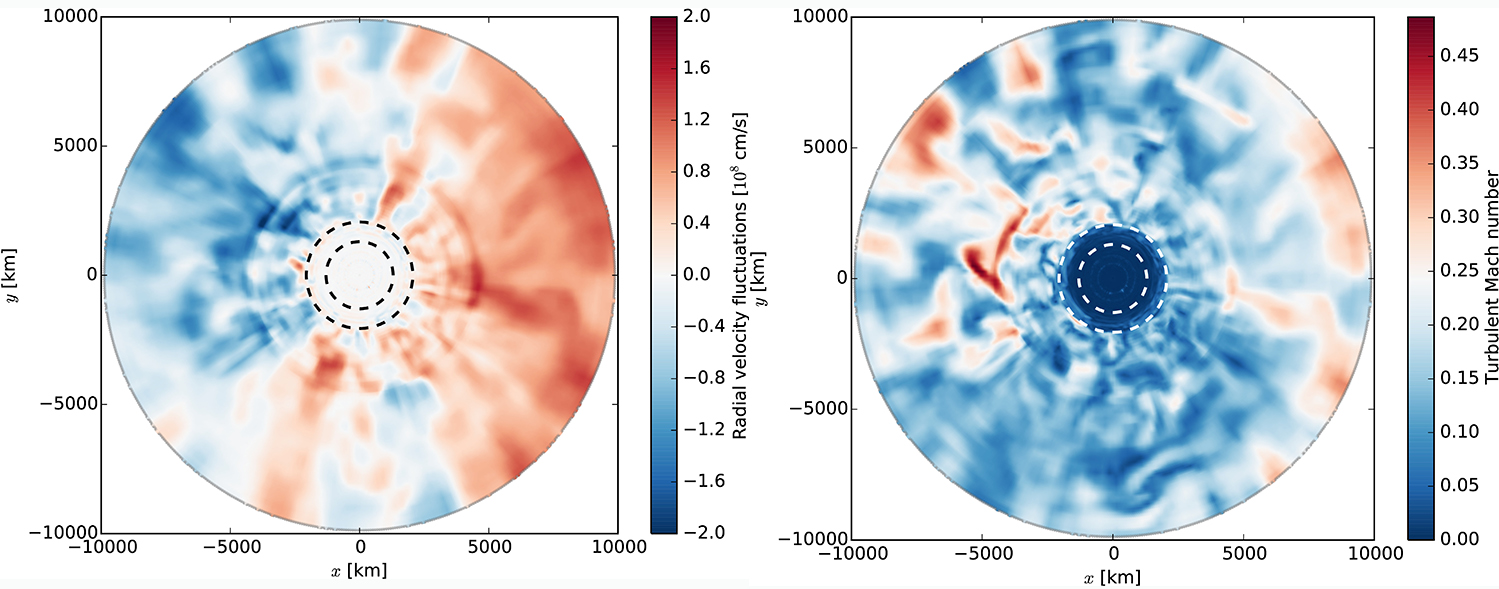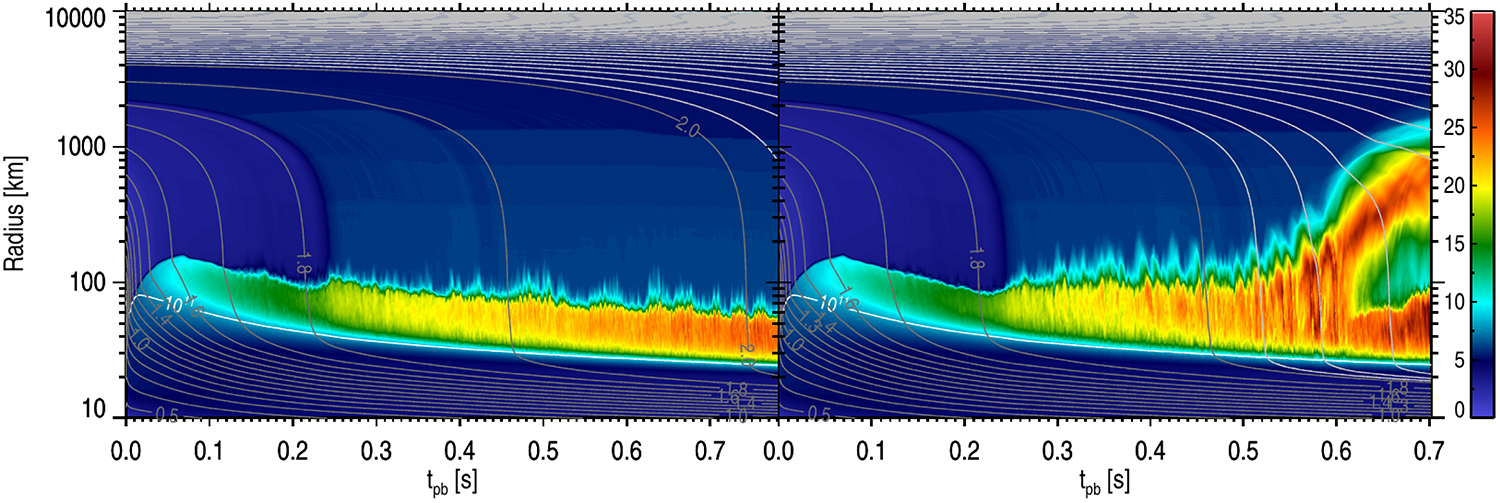ASTROPHYSICS
3D Supernova Simulations with 3D Progenitors and Muon Physics
Principal Investigator:
Hans-Thomas Janka
Affiliation:
Max-Planck-Institut für Astrophysik, Garching (Germany)
Local Project ID:
pr53yi
HPC Platform used:
SuperMUC of LRZ
Date published:
Introduction
Over millions of years massive stars evolve through a sequence of nuclear burning stages, building up a degenerate core of iron that is surrounded by shells of silicon, oxygen and neon, carbon, helium and hydrogen as “ashes” of the successive nuclear reactions. Finally, the iron core becomes gravitationally unstable and collapses to a neutron star or black hole within less than one second. The huge amount of gravitational binding energy released in the collapse can power a supernova (SN) explosion, in which the outer shells of the progenitor star are expelled with velocities up to roughly 10 percent of the speed of light.
The physical cause for the explosion is debated for more than 50 years already. One of the mechanisms invokes energy deposition by neutrinos around the newly formed neutron star. Neutrinos are nearly massless, elementary particles, which are radiated in huge numbers by the extremely hot (up to several 100 billion Kelvin) matter in the neutron star. The neutrinos carry away the binding energy of the compact remnant, which exceeds the energy of a typical SN by more than a factor 100. The absorption of only one percent of the neutrinos in the plasma surrounding the neutron star is therefore sufficient to explain the powerful SN blast.
Only recently modern three-dimensional (3D) neutrino-hydrodynamical simulations have been able to provide quantitative confirmation for the viability of this long-standing theoretical scenario of neutrino-driven explosions. The team of the PI participates in a worldwide effort in a leading position, using most advanced numerical tools (the Prometheus-Vertex code) and being supported by an Advanced Grant of the European Research Council, entitled “Modeling Stellar Collapse and Explosion: Evolving Progenitor Stars to Supernova Remnants” [1]. Goal of this project is the consistent 3D modeling of SN explosions from the final phase of convective shell burning through stellar collapse and explosion towards the early SN remnant evolution. Owing to GCS and PRACE computer-time grants also on SuperMUC, the PI’s team has achieved to obtain neutrino-driven SN explosions in some cases [2].
Results and Methods
However, the success was not straightforward. The first generation of 3D models computed by the Garching group did not explode, in contrast to previous axisymmetric (2D) simulations. To obtain SN explosions, the models had to be tweaked by invoking rapid progenitor rotation or a ~15% reduction of the neutral-current neutrino-nucleon scattering. Both effects had to be assumed larger than is compatible with our present knowledge of neutrino-interaction physics and stellar evolution of SN progenitors.
These results suggest that some important ingredients may still be missing in state-of-the-art 3D simulations. One possibility is a lack of numerical resolution, which is severely constrained by the enormous CPU-time needed for the calculation of neutrino transport and interactions. Indeed, resolution studies with simplified toy models suggest that a finer spatial grid reduces numerical viscosity and turbulent dissipation and thus can foster explosions (see SuperMUC project pr48ra). Whether this effect is sufficiently strong in full-fledged SN simulations can presently not be answered due to a lack of computational resources. SuperMUC cannot stably provide more than the currently used ~16000 processor cores, which are only sufficient to compute models with two degrees angular resolution, requiring still more than half a year of permanent computing for a single SN run.
Another possible deficiency concerns remaining and unavoidable simplifications of the neutrino-transport treatment, because present-day supercomputers are by far not powerful enough to rigorously solve the time-dependent Boltzmann transport equation in six-dimensional phase (i.e., 3D position and 3D momentum) space for all three flavors of neutrinos and antineutrinos.Therefore the Prometheus-Vertex code of the PI’s team makes use of the so-called "ray-by-ray plus" (RbR+) approximation, in which the radiation intensity is assumed to be axially symmetric around the radial direction in every point of the spatial polar coordinate (or axis-free Yin-Yang) grid. Hereby nonradial components of the neutrino fluxes are ignored. Comparing to alternative transport treatments, however, shows very satisfactory reliability of results based on the RbR+ approximation for the problem considered (see SuperMUC project pr62za).

Figure 1: Radial component of velocity fluctuations (left) and turbulent Mach number (right) for a ∼19 solar-mass star at the moment of core bounce. Dashed black and white circles mark the boundaries between the oxygen and silicon layers (outer circle) and between the silicon shell and the iron core, respectively. The turbulent Mach numbers exceed a value of 0.45 in some of the high-velocity patches.
Copyright: MPI für Astrophysik, Garching (Germany)In project (pr53yi) described here, two other new ingredients in SN modeling are investigated in their consequences. The first aspect concerns the initial conditions. Traditionally, progenitor models were adopted from 1D calculations of stellar evolution to the onset of core collapse (2D or 3D calculations over millions of years of evolution are not feasible). Since the Prometheus-Vertex code maintains sphericity in 3D when starting with spherical initial data, we usually have to introduce artificial (small) seed perturbations to initiate the development of nonradial hydrodynamical flows (convective overturn, the standing accretion-shock instability, turbulence) in regions where these instabilities are expected to grow. However, because of convective burning at the base of the silicon and oxygen shells, natural perturbations should exist in the progenitor star at the stage when its core begins to collapse. Within this project we have computed the final episode of oxygen-shell burning of a ~19 solar mass star, going back in time seven minutes before the gravitational instability of the iron core sets in. Huge dipolar flows develop in the oxygen layer at this stage, exhibiting turbulent Mach numbers up to >0.45 (Fig. 1). These large-scale flows have been demonstrated to potentially have severe ramifications for the development of turbulence in the postshock layer. Stronger turbulent activity supports the shock revival by neutrino heating and thus can enable neutrino-driven explosions [3].
The second new aspect taken into account in the simulations performed for this project is the inclusion of muons and of the corresponding neutrino interactions in the hot, dense medium of the newly formed neutron star. This physics has been ignored so far in SN modeling because of the long-standing prejudice that muons (because of ~105 MeV rest mass) are not important during the early phase of the proto-neutron star evolution. However, a detailed analysis reveals that significant numbers of muons can be created by electromagnetic (“thermal”) pair processes and by the conversion of degenerate electrons to negative muons through weak interactions. Since the initial muon number in the collapsed stellar core vanishes and because muon antineutrinos escape faster from the dense interior, the neutron star muonizes during its cooling evolution. This is in stark contrast to the deleptonization with respect to electron-lepton number, which goes hand in hand with the conversion of the proton-rich pre-collapse state to the final conditions in a neutron-dominated cool neutron star.

Figure 2: Mass-shell plot with entropy (in kB per nucleon) color coded for 2D SN simulations of a 20 solar-mass star. The model on the left does not include muons and does not explode. In contrast, the model on the right includes muons and therefore develops an explosion, visible by the outgoing shock front (see [4]).
Copyright: MPI für Astrophysik, Garching (Germany)2D SN simulations including muons performed by the PI’s team for the first time, have demonstrated that successful explosions can be obtained in cases where the models fail to explode without muons (Fig. 2 and [4]). This success is facilitated by a muon-induced faster contraction of the nascent neutron star. The consequence is higher neutrino emission and corresponding enhanced neutrino-energy transfer behind the stalled SN shock.
On-going Research and Outlook
No conclusive results could be obtained yet for our 3D SN simulations with muons and 3D initial conditions. Because 6-species (instead of 3-species) neutrino transport is needed to account for the muon physics self-consistently, the computations are considerably more expensive than without muons. Since only 120 million core-hours were granted on SuperMUC instead of the requested 151 million core-hours, the SN runs are still ongoing at the present time and further CPU-resources are needed.
Researchers
Robert Bollig, Alexander Heger, Hans-Thomas Janka (PI), Andreas Marek, Tobias Melson, Bernhard Müller, Alexander Heger
Project partners
Max Planck Computing and Data Facility/MPCDF (Garching), Monash University (Australia)
References and Links
[1] mpa.iwww.mpg.de/220337/Modeling-Stellar-Collapse-and-Explosion
[2] H.-Thomas Janka, Tobias Melson, and Alexander Summa. 2016. Physics of Core-Collapse Supernovae in Three Dimensions: A Sneak Preview. Annu Rev Nucl Part S, 66, 1 (2016), 341–375. DOI: https://doi.org/10.1146/annurev-nucl-102115-044747
[3] .B. Müller, T. Melson, A. Heger, and H.-T. Janka. 2017. Supernova Simulations From a 3D Progenitor Model - Impact of Perturbations and Evolution of Explosion Properties. Mon Not R Astron Soc, 472, 1 (2017), 491–513. https://doi.org/10.1093/mnras/stx196
[4] R. Bollig, H.-T. Janka, A. Lohs, G. Martinez-Pinedo, C. J. Horowitz, and T. Melson. 2017. Muon Creation in Supernova Matter Facilitates Neutrino-Driven Explosions. Phys Rev Lett, 119, 4 (2017), id.242702. https://doi.org/10.1103/PhysRevLett.119.242702
Scientific Contact:
Prof. Dr. Hans-Thomas Janka
Max-Planck-Institut für Astrophysik, Garching
Karl-Schwarzschild-Straße 1
D-85748 Garching (Germany)
e-mail: thj [@] MPA-Garching.MPG.DE
NOTE: This report was first published in the book "High Performance Computing in Science and Engineering – Garching/Munich 2018".
LRZ project ID: pr53yi
March 2019